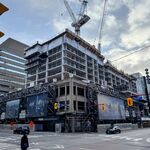vultur
Active Member
Otherwise, as you point out yourself, many or most investments would not be made, as the operating return is usually less than the cost of capital, or sometimes less even than could be achieved in a risk-free Canada bond. In a scenario where only the operating income were considered, we would have very little rental real estate available!
Real estate investment analysis quite explicitly takes into account both components of the projected return, the operating income and the anticipated capital gain.
That's where we differ slightly OW. I submit that a stabilized real estate investment (ie where existing rent is at or close to market rent) must yield more than the cost of capital and thus produce positive leverage. In a market like Toronto where new condo rentals are free from regulation the going in rent is the market rent and given the enormous supply coming on stream in most areas of town you can bet the supply will more keep up with the demand in most locations. To assume higher than inflation rental price increases in the future would in my opinion be incorrect and given the high vacancy rate in Toronto in recent years I would argue that the trend is more towards a tougher rental market going forward. That is the way this game has been played as long as I've been involved and those are the rules that I was taught by my predecessors. The higher than bond yield is effectively a benefit that should rightfully be bestowed on the owner for assuming a higher risk activity than parking his capital in a low risk debt instrument (ABCP meltdown notwithstanding).
The recent wave of negative leverage purchases by individuals and syndicate groups who I personally characterize as specuvestors is to me indicative of a trend that was formed under the false assumption that real estate cannot lose value. The fallout from that erroneous assumption is being felt very hard in markets like San Diego, Miami and Los Vegas. In effect, it is a ponzi scheme mentality and not a true investor mentality. Blame the enormous amount of excess capital floating around in the world for this trend of underpricing risk in the market. I recognize that buyers of condos in Toronto in the past several years have seen a reasonable amount of appreciation but I submit that has been more a function of the self-perpetuating trend that can be unwound quite easily than a function of sound investment strategy.




